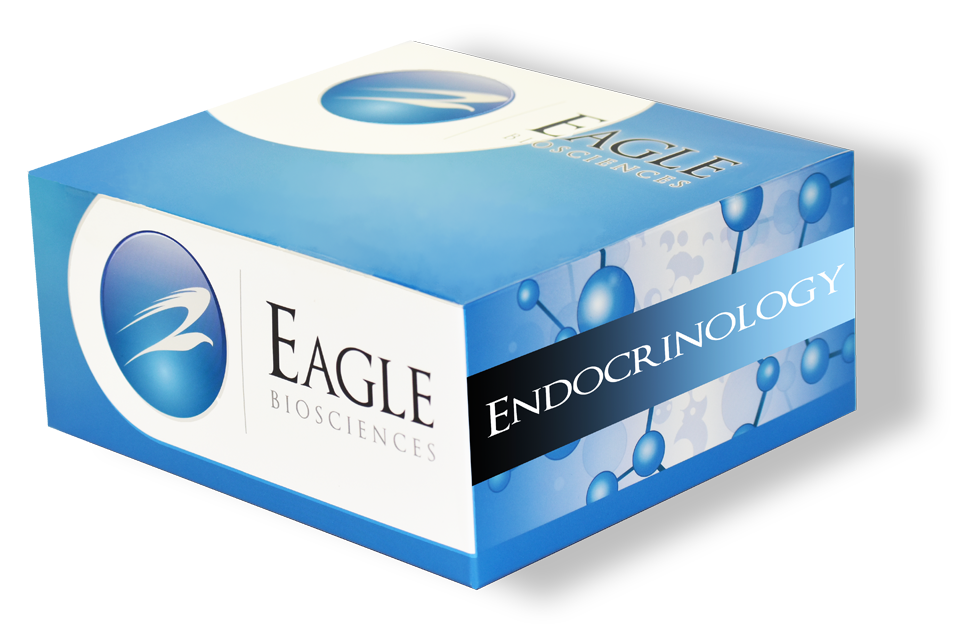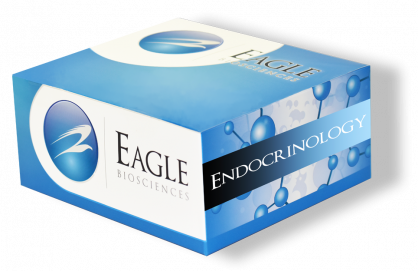Rat Urocortin 2 ELISA Assay
The Rat Urocortin 2 ELISA Assay is For Research Use Only
Size: 1×96 wells
Dynamic Range: 1.563 – 100 ng/mL
Incubation Time: 21 hours
Sample Type: Rat Serum, Plasma
Sample Size: 50 µL
Alternative Names: UCN 2, Stresscopin-related Peptide
Stability and Storage
Storage: Store all the components at 2~8°C.
Shelf life: The kit is stable under the condition for 15 months from the date of manufacturing. The expiry date is stated on the package.
Package: For 96 tests per one kit including standards.
Assay Principle
Eagle Biosciences Rat Urocortin 2 ELISA for determination of rat urocortin 2 in samples is based on a competitive enzyme immunoassay using combination of highly specific antibody to rat urocortin 2 and biotin-avidin affinity system. To the wells of plate coated with rabbit anti rat urocortin 2 antibody, standards or samples and labeled antigen (biotinylated antigen) are added for competitive immunoreaction. After incubation and plate washing, horseradish peroxidase (HRP) labeled streptoavidin (SA) is added to form HRP labeled SA-labeled antigen-antibody complex on the surface of the wells. Finally, HRP enzyme activity is determined by 3,3’,5,5’-Tetramethylbenzidine (TMB) and the concentration of rat urocortin 2 is calculated.
Related Products
Mouse Urocortin 2 ELISA Assay
Mouse Rat Urocortin 1 ELISA Assay Kit
Mouse Rat Urocortin 3 ELISA Assay Kit
Assay Background
Urocortin 2 (Ucn 2), also known as stresscopin-related peptide, is a novel predicted neuropeptide related to corticotropin-releasing factor (CRF). The peptide consisting of 38 amino acid residues was first demonstrated to be expressed centrally and to bind selectively to type 2 CRF receptor (CRFR2)1). In the rodent, Ucn 2 transcripts were shown to be expressed in the discrete regions of the central nervous system including stress-related cell groups in the hypothalamus and brainstem1). More recently, the expression of Ucn 2 transcripts was detected in the olfactory bulb, pituitary, cortex, hypothalamus, and spinal cord2). Ucn 2 mRNA was also found to be expressed widely in a variety of peripheral tissues, most highly in the skin and skeletal muscle tissues3). Ucn 2-like immunoreactivity was detected by RIA in acid extracts of mouse brain, muscle, and skin3). Immunohistochemically Ucn 2 was found in both skin epidermis and adnexal structures and in the skeletal muscle myocytes3). Ucn 2 gene transcription was stimulated in the hypothalamus and brainstem by glucocorticoid administration to the mouse and inhibited by removal of glucocorticoids by adrenalectomy, suggesting a putative link between the CRFR1 and CRFR2 pathways2). On the other hand, in the rat a stressor-specific regulation of Ucn 2 mRNA expression in the hypothalamic paraventricular nucleus was demonstrated, which raised the possibility of a modularly role of Ucn 2 mRNA in stress-induced alteration of anterior and posterior pituitary function, depending on the type of stress4). Administration of dexamethasone to the mouse resulted in a decrease of Ucn 2 mRNA levels in the back skin region. Adrenalectomy significantly increased Ucn 2 mRNA levels in the skin, and the levels were reduced back to normal levels after corticoid replacement 3).
CRFR2 is found in cardiomyocytes and in endothelial and smooth muscle cells of the systemic vasculature. Ucn 2 is expressed in the mouse cardiomyocytes. In the mouse, Ucn 2 treatment augmented heart rate, exhibited potent inotropic and lusitropic actions on the left ventricle, and induced a downward shift of the diastolic pressure-volume relation5). Ucn 2 also reduced systemic arterial pressure, associated with a lowering of systemic arterial elastance and systemic vascular resistance. The effects of Ucn 2 were specific to CRFR2 function and independent of beta-adrenergic receptors. These experiments demonstrated the potent cardiovascular physiologic actions of Ucn 2 in the both wild-type and cardiomyopathic mice and support a potential beneficial use of Ucn 2 in congestive heart failure treatment5). The use of Ucn 2 was also proposed to treat ischemic heart disease because of its potent cardioprotective effect in the mouse heart and its minimal impact on the hypothalamic stress axis6).
Administration of Ucn 2 to the mouse prevented the loss of skeletal muscle mass resulting from disuse due to casting, corticosteroid treatment, and nerve damage. In addition, Ucn 2 treatment prevented the loss of skeletal muscle force and myocyte cross-sectional area that accompanied muscle mass losses resulting from disuse due to casting. In normal muscles of the mouse, Ucn 2 increased skeletal muscle mass and force. It was thus proposed that Ucn 2 might find utility in the treatment of skeletal muscle wasting diseases including age-related muscle loss or sarcopenia7).
Mouse urocortin 2 (Ucn 2) is a new peptide predicted from mouse cDNA sequence and its physiologic and pathophysiologic significance has not yet been fully elucidated. However, the experimental data presented to date provided evidence for the important physiologic roles of Ucn 2 and urge the necessity of further investigation of the peptide from various points of view.
We have already developed mouse/rat urocortin 1 (Ucn1) EIA kit (YK210), mouse urocortin 2 (Ucn2) EIA kit (YK190) and mouse/rat urocortin 3 (Ucn3) EIA kit (YK200). This time, as a part of tools for urocortin research, our laboratory developed rat urocortin 2 (Ucn2) EIA kit (YK191), which highly specific for rat Ucn 2 with almost no crossreaction to Ucn 1 (mouse, rat), Ucn 2 (mouse), Ucn 3 (mouse, rat), and CRF (mouse, rat, human). The kit can be used for measurement of Ucn 2 in rat plasma or serum with high sensitivity. It will be a specifically useful tool for rat Ucn 2 research.
Assay Principle
Eagle Biosciences Rat Urocortin 2 ELISA Assay kit for determination of rat urocortin 2 in samples is based on a competitive enzyme immunoassay using combination of highly specific antibody to rat urocortin 2 and biotin-avidin affinity system. To the wells of plate coated with rabbit anti rat urocortin 2 antibody, standards or samples and labeled antigen (biotinylated antigen) are added for competitive immunoreaction. After incubation and plate washing, horseradish peroxidase (HRP) labeled streptoavidin (SA) is added to form HRP labeled SA-labeled antigen-antibody complex on the surface of the wells. Finally, HRP enzyme activity is determined by 3,3’,5,5’-Tetramethylbenzidine (TMB) and the concentration of rat urocortin 2 is calculated.
Assay Procedure
- Before starting the assay, bring all the reagents and samples to room temperature (20 ~ 30ºC).
- Fill 0.3 mL/well of washing solution into the wells and aspirate the washing solution in the wells. Repeat this washing procedure further twice (total 3 times). Finally, invert the plate and tap it onto an absorbent surface, such as paper toweling, to ensure blotting free of most residual washing solution.
- Add 50uL of buffer solution to the wells first, then introduce 50uL of each of standard solutions (0, 1.563, 3.125, 6.25, 12.5, 25, 50 and 100 ng/mL) or samples and finally add 50uL of labeled antigen to the wells. The total pipetting time of standard solutions and samples for a whole plate should not exceed 30 minutes.
- Cover the plate with adhesive foil and incubate it at 4ºC for 16~18 hours (keep still, plate shaker not need).
- After incubation, move the plate back to room temperature keeping for approximately 40 minutes (keep still, plate shaker not need) and take off the adhesive foil, aspirate and wash the wells 4 times with 0.3 mL/well of washing solution. Finally, invert the plate and tap it onto an absorbent surface, such as paper toweling, to ensure blotting free of most residual washing solution.
- Add 100uL of SA-HRP solution to each of the wells.
- Cover the plate with adhesive foil and incubate it at room temperature for 2 hours.
- During the incubation, the plate should be shaken with a plate shaker (approximately 100 rpm).
- Take off the adhesive foil, aspirate and wash the wells 4 times with 0.3 mL/well of washing solution. Finally, invert the plate and tap it onto an absorbent surface, such as paper toweling, to ensure blotting free of most residual washing solution.
- Add 100uL of Enzyme substrate solution (TMB) to each of the wells, cover the plate with adhesive foil and keep it for 30 minutes at room temperature in a dark place for color reaction (keep still, plate shaker not need).
- Add 100uL of stopping solution to each of the wells to stop color reaction.
- Read the optical absorbance of the solution in the wells at 450 nm. The dose-response curve of this assay fits best to a 4 (or 5)-parameter logistic equation. The results of unknown samples can be calculated with any computer program having a 4 (or 5)-parameter logistic function. Otherwise calculate mean absorbance values of wells containing standards and plot a standard curve on semi logarithmic graph paper (abscissa: concentration of standard; ordinate: absorbance values). Use the average absorbance of each sample to determine the corresponding value by simple interpolation from this standard curve.
Typical Standard Curve




